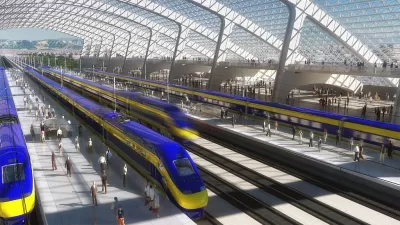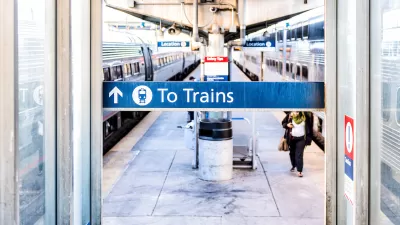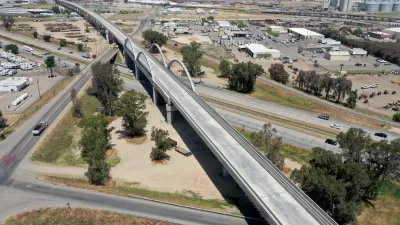If state lawmakers can agree to support matching funds for the project, California's high-speed rail could compete for $36 billion in new federal grants.

The $36 billion in federal high-speed rail grants passed in the infrastructure bill could help California accelerate its high-speed rail project, writes Roger Rudick. "For some perspective on California’s ability to compete for federal high-speed rail funds: in 2009, California’s project was awarded $3.5 billion from an $8 billion federal high-speed rail package. And that was when the project was still just a bunch of blueprints," Rudick says.
The project, currently under construction in California's Central Valley, has faced delays and opposition from lawmakers who disagree with the planned route or want the funds spent on improving local transit instead, obstructing state funding needed to match federal grants. According to Rudick,
That’s why the biggest remaining challenge to completing the project is the Democrat majority state legislature. Assemblymembers Anthony Rendon and Laura Friedman, ironically, don’t seem to want the project to ever reach their own constituents in Los Angeles. Currently, they are holding up over $4 billion in voter-approved bond money for the project, which was allocated by Governor Newsom but rejected by these legislators.
Rudick calls for state legislators to support high-speed rail and release the funds needed to move the project forward, commit to electric trains, and compete for a slice of the new federal funding.
FULL STORY: Feds Pass Downpayment for Next Phase of California High-Speed Rail

Alabama: Trump Terminates Settlements for Black Communities Harmed By Raw Sewage
Trump deemed the landmark civil rights agreement “illegal DEI and environmental justice policy.”

Study: Maui’s Plan to Convert Vacation Rentals to Long-Term Housing Could Cause Nearly $1 Billion Economic Loss
The plan would reduce visitor accommodation by 25% resulting in 1,900 jobs lost.

Planetizen Federal Action Tracker
A weekly monitor of how Trump’s orders and actions are impacting planners and planning in America.

Waymo Gets Permission to Map SF’s Market Street
If allowed to operate on the traffic-restricted street, Waymo’s autonomous taxis would have a leg up over ride-hailing competitors — and counter the city’s efforts to grow bike and pedestrian on the thoroughfare.

Parklet Symposium Highlights the Success of Shared Spaces
Parklets got a boost during the Covid-19 pandemic, when the concept was translated to outdoor dining programs that offered restaurants a lifeline during the shutdown.

Federal Homelessness Agency Places Entire Staff on Leave
The U.S. Interagency Council on Homelessness is the only federal agency dedicated to preventing and ending homelessness.
Urban Design for Planners 1: Software Tools
This six-course series explores essential urban design concepts using open source software and equips planners with the tools they need to participate fully in the urban design process.
Planning for Universal Design
Learn the tools for implementing Universal Design in planning regulations.
Caltrans
Smith Gee Studio
Institute for Housing and Urban Development Studies (IHS)
City of Grandview
Harvard GSD Executive Education
Toledo-Lucas County Plan Commissions
Salt Lake City
NYU Wagner Graduate School of Public Service





























